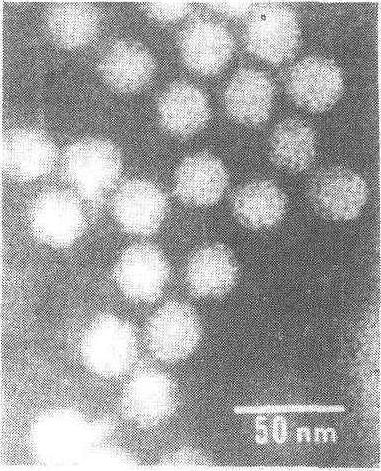病毒性软化病viral flacherie
桑蚕病毒病的一种,是由软化病病毒寄生而引起的传染性蚕病,各蚕区夏秋蚕期常有发生,俗称空头病。在很长一段时间内,认为本病主要是因蚕体虚弱致使非特异性的肠道细菌大量繁殖而引起的,到1960年国内外相继证实,病毒性软化病是由病毒引起的。
病原 桑蚕传染性软化病毒属细小核糖核酸病毒科,学名为Bombyx mori infectious-flacherieVirus简称FV或IFV。病毒粒子呈球状,直径为25~30毫微米,平均为26±2毫微米,沉降系数为180S。核酸为单链核糖核酸(ssRNA),分子量接近2×106。编码为R/1:2.4/29:s/s:I/0(见图)。
本病毒在蚕体细胞内不形成多角体,故属于非封闭型的裸露粒子。经纯化的FV可以作为抗原,注射到山羊、家兔等动物体内能形成抗体,获得免疫血清。本病毒能凝集小鼠的红血球,这种凝集反应当存在抗FV血清时就被阻碍,但不能与山羊、绵羊、鸡及人的红血球产生凝集反应。

桑蚕病毒性软化病病毒
桑蚕软化病病毒的稳定性,因其存在的状态及环境而有显著的差异。FV存在于病蚕尸体或病蚕粪中,在室内保存2~3年仍有致病力。蚕粪中的FV经100℃干热处理30分钟仍未失活。保存于-18℃虽经500天仍保持很强的致病力。FV被家畜、家禽食下后在排出的粪便中仍有致病力。由于本病毒传染致病力很强,在养蚕上应特别加以注意。软化病病毒,在35.7℃的日光直晒29小时,100℃温度接触3~5分钟和含2%甲醛液在20~27℃接触3~10分钟,含0.3%有效氯的漂白粉液内经3~5分钟,0.5%的石灰浆中经3~4分钟都能使之失去致病力。
传染 病毒性软化病主要是通过食下传染。FV进入消化道以后,也可能受抗病毒物质的作用而部分失活。
FV主要感染中肠杯形细胞,不形成多角体。杯形细胞被感染后,细胞质肥厚,线粒体减少。后来细胞收缩、退化而成球状体。FV侵入中肠后感染中肠前端的杯形细胞,渐次向后端扩展。崩坏的细胞及病毒散落到肠腔内,所以蚕粪中含有大量病毒。
用砒罗红—甲基绿染色的中肠涂片,光学显微镜检查或切片可见存在于圆筒形细胞质中的桃红色A型,以及单独游离存在的B型球状体,这种嗜碱性的球状体都是退化的杯形细胞。当杯形细胞遭到破坏后,新生细胞不断分化补充。如新生细胞增生的速度能弥补损坏的杯形细胞时,则可延长蚕的病程。这是一种耐病现象。
FV在中肠内的增殖与核型多角体病、质型多角体病的病毒增殖情况基本相同。用接种FV以后病蚕中肠内的病毒增殖也可分成隐潜期、缓慢增殖期、高速(对数)增殖期及稳定(减速)增殖期4个阶段。FV的增殖速度受饲养温度的影响,在25℃~30℃的范围内增殖速度较快;在16℃则很缓慢;37℃对病毒的增殖有一定的抑制作用。在这种条件下,未受感染的或新形成的杯形细胞可以免遭病毒的感染。FV主要感染中肠杯形细胞,由于杯形细胞的机能是分泌消化液,既有消化分解桑叶的作用,同时又有抑菌、灭毒的功能。感染后杯形细胞退化、脱落,致使消化及杀菌功能受到影响。因此,肠道内的细菌极易大量繁殖。在病毒及细菌的共同侵染的情况下加速了蚕的死亡。用人工饲料无菌育条件下,接种FV时蚕的死亡期明显延长,这可能是无菌状态时,细菌的影响较小,杯形细胞的脱落与中肠的再生能力容易保持平衡的结果。
病症 本病的症状因发病时期不同而异。发病初期仅见蚕食桑减少,发育不良,眠起不齐。个体间大小差别较大。有起缩、空头、缩小、下痢和吐液等症状。死后尸体扁瘪,这种病症和病程上的多样性,大都与伴随病毒感染而繁殖的肠道细菌的种类和数量有关。单独的FV感染时病程比较长。起缩症状在各龄饷食后1~2天内、特别是5龄起蚕出现较多。病蚕很少食桑或完全停止食桑。在群体中体色灰暗不见转青,体躯缩小,体壁多皱。有时吐液,排黄褐色稀粪或污液,萎缩而死。空头症状在各龄盛食期出现,特别是大蚕期出现较多。病蚕很少食桑,体色失去原有的青白色(桑色),胸部稍膨大,半透明微带淡暗红色。渐次全身呈半透明,排稀粪或污液。死亡前吐液,死后尸体软化,严重发病时,蚕座及蚕室有异常的臭气。
病蚕发病经过天数,因蚕龄、感染病毒的数量及细菌繁殖情况而不同。但一般经5~12天死亡。病症与细菌性胃肠病相似。但病毒性软化病具有传染性强,病势严重持续蔓延等特点,其病症还与质型多角体病有很多相似之处,主要区别是中肠的病变,本病蚕中肠不呈乳白色; 粪便无乳白色而呈黑褐色污液; 镜检无多角体而有大量细菌。
诊断与防治 应用血清学的琼脂糖双向免疫扩散、对流免疫电泳、荧光抗体法进行诊断最为精确。与细菌性胃肠病的区别主要从群体的病情来判断,本病的病势比较严重,病情陆续不断。如病情较轻,拣去病蚕后即不再发病,则多属细菌性胃肠病。
显微镜检查本病蚕肠液,可见有大量的双球菌、球菌、无多角体。还可切取病蚕中肠组织一小块 (长宽各2~3毫米),制成涂片标本,用卡诺氏固定液固定水洗。砒罗红-甲基绿染色趁湿即盖上盖玻片。在400~600倍显微镜下镜检。在圆筒形细胞中央有紫红色的细胞核,靠近核的细胞质处有被砒罗红染成桃红色的A型球状体以及单独游离存在的B型球状体。
当用肉眼及显微镜检查尚不能诊断时,可进行感染试验。用镜检无多角体的病蚕中肠匀浆,加10倍无菌水稀释,在1,000转/分离心10分钟,取上清液涂于桑叶叶面给蚁蚕添食,如出现同样的病症时,可确诊为病毒性软化病。
病毒性软化病的防治方法是消灭病原杜绝感染机会,提高饲料质量和改善饲养条件增强体质。❶蚕室、蚕具均应按消毒规范所规定的要求履行消毒。
❷严格分批提青,隔离或淘汰发育不良及有病蚕,防止蚕座传染。
❸饲养中掌握温、湿度,注意桑叶的选择、贮藏,增强蚕体体质提高蚕体抗病力。